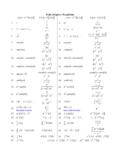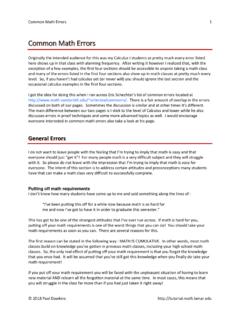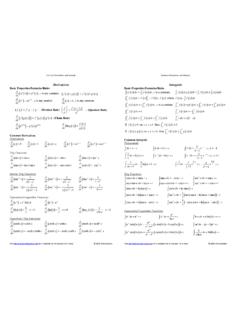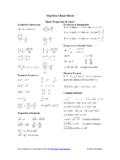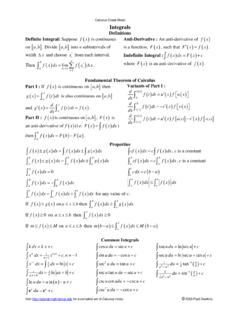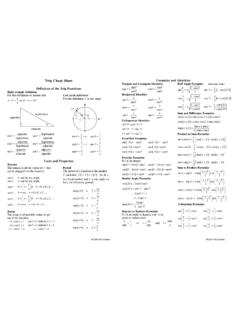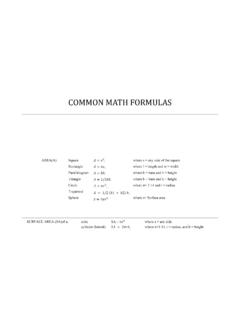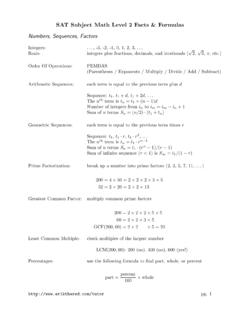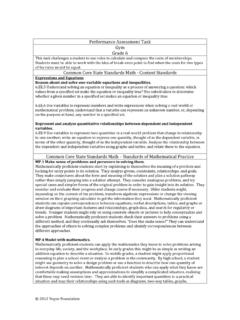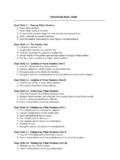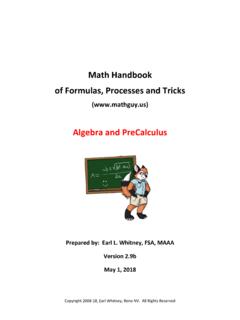Transcription of nn) (cx ncx nn) - Pauls Online Math Notes
1 common derivatives and Integrals derivatives Basic Properties/Formulas/Rules d dx ( cf ( x ) ) = cf ( x ) , c is any constant. ( f ( x ) g ( x ) ) =f ( x ) g ( x ). d n dx ( x ) = nx n 1 , n is any number. d dx ( c ) = 0 , c is any constant. f f g f g . (f =g ) f g + f g (Product Rule) = (Quotient Rule). g g2. d dx ( ). f ( g ( x ) ) = f ( g ( x ) ) g ( x ) (Chain Rule). g ( x). dx e( ). d g ( x). = g ( x) e ( ). g x d dx ( ln g ( x ) ) =. g ( x). common derivatives Polynomials d dx (c) = 0. d dx ( x) = 1. d dx ( cx ) = c d n dx ( x ) = nx n 1 d dx ( cx n ) = ncx n 1. Trig Functions d d d ( sin x ) = cos x ( cos x ) = sin x ( tan x ) = sec2 x dx dx dx d d d ( sec x ) = sec x tan x ( csc x ) = csc x cot x ( cot x ) = csc2 x dx dx dx Inverse Trig Functions d ( sin 1 x ) =. 1 d ( cos 1 x ) =.
2 1 d ( tan 1 x ) =. 1. 1 + x2. dx 1 x2 dx 1 x2 dx d ( sec 1 x ) =. 1 d ( csc 1 x ) = . 1 d ( cot 1 x ) = . 1. 1 + x2. dx x x2 1 dx x x2 1 dx Exponential/Logarithm Functions (. d x dx a ) = a x ln ( a ). d x dx ( e ) = ex d dx ( ( x )) , x > 0. ln =. 1. x d dx ( ln=x). 1. x , x 0. d dx ( =. log a ( x )). 1. x ln a , x>0. Hyperbolic Trig Functions d d d ( sinh x ) = cosh x ( cosh x ) = sinh x ( tanh x ) = sech 2 x dx dx dx d d d ( sech x ) = sech x tanh x ( csch x ) = csch x coth x ( coth x ) = csch 2 x dx dx dx Visit for a complete set of Calculus I & II Notes . 2005 Paul Dawkins common derivatives and Integrals Integrals Basic Properties/Formulas/Rules cf ( x ) dx = c f ( x ) dx , c is a constant. f ( x ) g ( x ) dx = f ( x ) dx g ( x ) dx a f ( x=. ) dx F (=. x) a F ( b ) F ( a ) where F ( x ) = f ( x ) dx b b a cf ( x ) dx = c a f ( x ) dx , c is a constant.
3 A f ( x ) g ( x ) dx= a f ( x ) dx a g ( x ) dx b b b b b f ( x ) dx = 0 f ( x ) dx = f ( x ) dx a b a a a b f ( x ) dx f ( x ) dx + f ( x ) dx dx c ( b a ). b c b b =. a a c a c=. If f ( x ) 0 on a x b then a f ( x ) dx 0. b If f ( x ) g ( x ) on a x b then f ( x ) dx g ( x ) dx b b a a common Integrals Polynomials 1 n +1. dx= x+c k dx = k x+c x dx = x + c, n 1. n n +1. 1= 1. x = x=. n dx ln x + c 1. dx ln x + c dx x n +1 + c, n 1. x n + 1. p p p+q 1 = 1 1 q +1 q ln ax + b + c =. x q dx x= +c +c q dx x ax + b a q +1. p p+q Trig Functions cos u=. du sin u + c sin u du = cos u + c sec u= du tan u + c 2. sec u tan u=. du sec u + c csc u cot udu = csc u + c csc u du = cot u + c 2. tan = u du ln sec u + c cot = u du ln sin u + c sec u du= ln sec u + tan u + c sec =u du 1. 2. ( sec u tan u + ln sec u + tan u ) + c 3.
4 Csc u du= ln csc u cot u + c csc 3 1. u du = . 2. ( csc u cot u + ln csc u cot u ) + c Exponential/Logarithm Functions au e u du= e + c u a =. u du +c ln u=. du u ln ( u ) u + c ln a e au e sin ( bu=. au ) du a 2 + b2. ( a sin ( bu ) b cos ( bu ) ) + c ue du =( u 1) e u u +c e au 1=. e au cos ( =. bu ) du a 2 + b2. ( a cos ( bu ) + b sin ( bu ) ) + c . u ln u du ln ln u + c Visit for a complete set of Calculus I & II Notes . 2005 Paul Dawkins common derivatives and Integrals Inverse Trig Functions 1 u . du sin 1 + c sin 1. = du u sin 1 u + 1 u 2 + c u=. a2 u2 a . 1 u . du u tan 1 u ln (1 + u 2 ) + c 1 1. tan 1. = du tan 1 + c u=. a +u a . 2 2. a 2. 1 1 u . sec 1 + c cos 1. = du du u cos 1 u 1 u 2 + c u=. u u a 2 2 a a . Hyperbolic Trig Functions sinh=. u du cosh u + c sech u tanh u du =.
5 Sech u + c sech =. u du tanh u + c 2. cosh= sinh u + c csch u coth u du =. csch u + c csch u du =. coth u + c 2. u du =tanh u du ln ( cosh u ) + c =. sech u du tan sinh u + c 1. Miscellaneous = 1 1 u+a = 1 1 u a 2 du ln +c 2 du ln +c a u 2. 2a u a u a 2. 2a u + a u 2 a2. a + u du = a + u + ln u + a 2 + u 2 + c 2 2 2. 2 2. u 2 a2. u 2 a 2 du =. 2. u a 2 ln u + u 2 a 2 + c 2. u 2 a2 u . a 2 u 2 du =. 2. a u 2 + sin 1 + c 2 a . u a a2 a u . 2au =. u 2 du 2. 2au u 2 + cos 1 . 2 a . +c Standard Integration Techniques Note that all but the first one of these tend to be taught in a Calculus II class. u Substitution a f ( g ( x ) ) g ( x ) dx then the substitution u = g ( x ) will convert this into the b Given g (b). integral, f ( g ( x ) ) g ( x ) dx = f ( u ) du . b a g(a). Integration by Parts The standard formulas for integration by parts are, b b udv =.
6 Uv vdu a uv a vdu b udv =. a Choose u and dv and then compute du by differentiating u and compute v by using the fact that v = dv . Visit for a complete set of Calculus I & II Notes . 2005 Paul Dawkins common derivatives and Integrals Trig Substitutions If the integral contains the following root use the given substitution and formula . a a 2 b2 x2 x= sin and cos 2 = 1 sin 2 . b a b2 x2 a 2 x = sec and tan 2 = sec 2 1. b a a 2 + b2 x2 x= tan and sec 2 =1 + tan 2 . b Partial Fractions P ( x). If integrating dx where the degree (largest exponent) of P ( x ) is smaller than the Q ( x). degree of Q ( x ) then factor the denominator as completely as possible and find the partial fraction decomposition of the rational expression. Integrate the partial fraction decomposition ( ). For each factor in the denominator we get term(s) in the decomposition according to the following table.
7 Factor in Q ( x ) Term in Factor in Q ( x ) Term in A A1 A2 Ak ax + b ( ax + b ). k + + +. ax + b ax + b ( ax + b ) 2. ( ax + b ). k Ax + B A1 x + B1 Ak x + Bk ( ax 2 + bx + c ) + +. k ax 2 + bx + c ax + bx + c ( ax 2 + bx + c ). 2 k ax + bx + c 2. Products and (some) Quotients of Trig Functions sin x cos x dx n m 1. If n is odd. Strip one sine out and convert the remaining sines to cosines using sin 2 x = 1 cos 2 x , then use the substitution u = cos x 2. If m is odd. Strip one cosine out and convert the remaining cosines to sines using cos 2 x = 1 sin 2 x , then use the substitution u = sin x 3. If n and m are both odd. Use either 1. or 2. 4. If n and m are both even. Use double angle formula for sine and/or half angle formulas to reduce the integral into a form that can be integrated.
8 Tan x sec x dx n m 1. If n is odd. Strip one tangent and one secant out and convert the remaining tangents to secants using tan = 2. x sec 2 x 1 , then use the substitution u = sec x 2. If m is even. Strip two secants out and convert the remaining secants to tangents using sec 2 x = 1 + tan 2 x , then use the substitution u = tan x 3. If n is odd and m is even. Use either 1. or 2. 4. If n is even and m is odd. Each integral will be dealt with differently. ( cos x ) = (1 sin x ). 3 3. Convert Example : cos 6 x= 2 2. Visit for a complete set of Calculus I & II Notes . 2005 Paul Dawkins
